 Germany (1913-1919) U-31 to U-41, launched/commissioned 1914-15
Germany (1913-1919) U-31 to U-41, launched/commissioned 1914-15WW1 German U-Boats
Brandtaucher | Forelle | U-1 | U-2 | U-3 class | U-5 class | U-9 class | U-13 class | U-17 class | U-19 class | U-23 class | U-43 class | U-57 class | U-63 class | U-87 class | U-93 class | U-139 class | U-142 class | UA | UB-I class | UB-II class | UB-III class | UC-I class | UC-II class | UC-III | Deutschland | UE-I class | UE-II class | U-ProjectsU 31 class subs. Fourth entry after U1 and the UB series. The U31 class was arguably the most successful U-Boats class ever in service with the laiserliches Marine in 1914, aside the UB I serie. This was the first homogeneous class of oceanic U-Boats built in significant numbers, after small series of four ships or single boats, a cautious approach as grand admiral Tirpitz was still unconvinced of their utility and wanted to avoid diversion from his mighty surface fleet. In all, 11 boats were made (U-31 to U-41), 7 lost, many by Q-ships. They were faster diving, with a 7800 nautical miles range. U-35 became the best U-Boat of WWI and of all times, sinking 224 ships (536,000 GRT) between her four ace commanders, including W. Kophamel (also a WW2 U-ace) and the legendary Lothar von Arnault De la Periere. To compare the U-ace of aces on U-48 in WW2 sank 51 ships for 310,000 GRT… In fact they had the top-three-scoring uboats of the war, with also U-39 (Walter Forstmann) and U-38 (Max Valentiner) together claiming 1,198,139 gross register tons (GRT). Later on, another U-ace on U-38 and U-34, Wilhelm Canaris, became admiral and head of the Abwehr from 1935 to 1944.
The full story and individual careers. #kaiserlichesmarine #germannavy #ww1 #191418 #uboat #uboote #u35 #delaperiere #kophamel #submarine #battleatlantic
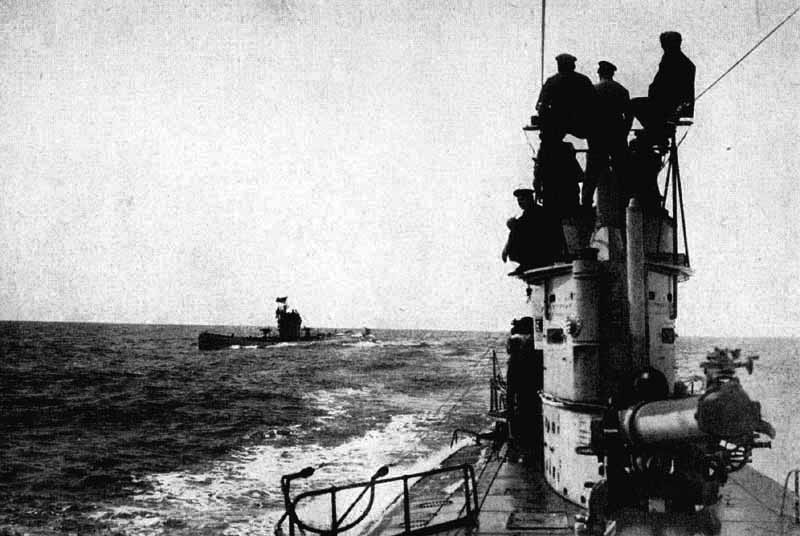
U-52 meeting U-35, two of the most successful submarines of all times.
Development
The U31 class followed a long line of U-Boats derived from U-1 from Germaniawerft and reflected the progresses made between August 1906 and January 1914, so in nine years. Compared to the latter, the new class displaced 860 tonnes versus 280 underwater, had four torpedo tubes instead of one, with larger torpedoes, a gun deck, and could reach 16.4 knots surfaced versus 10.5, 9.7 kts underwater versus 8.7 and with a range of 7800 nm versus 1500, so increased five fold.
This result was the fruit of nine years of gradual improvements in design, through the U2, U3, U5, U9, U13 classes, U16, class, U17, 19, 23 and 27 classes. All iterated on the base formula, the sold design made for surface performances and range rather than underwater speed or agility, as the admiralty considered them s torpedo boats that could disappear underwater of threatened, an approach soon similar to what happened in other navies, with different designs and formulas.
U1 was the brainchild of Spanish engineer D’Equevilley (which also work with Laubeuf in France on a winning design), and it was not designed for export by “by the navy and for the navy” at Friedrich Krupp, Germaniawerft on official specification.
The follow-up boats were also prototypes from Kiel and Dantzig yards, useful to show what these yards can do, and the first U5 serie was ordered to Germaniawerft (U5), the U9 and U13 series at Dantzig. The latter also built a serie of four U19 class which became the first diesel-electrically powered U-Boats. They also introduced 500 mm torpedo tubes and deck gun; Truly revolutionary, they inspired the order to Germaniawerft of the U23 serie, and at U27 Dantzig, each four boats to form squadrons.
Here comes the U-31 class. They were essentially Germaniawerft copies of its own U-23 class, but with a much faster diving time. Between 1912 and 1915 eleven were built at Germaniawerft, Kiel, as an evolution of the rival Dantzig design U-27 class, while being larger than the U-23 series (685/878 tonnes versus 669/864t) and same dimensions but greater draught.
Design of the class
The Type U 31 were double-hulled and ocean-going, drawing inspiration from the Type 23 and Type 27 in dimensions but having a reworked propulsion and speed and were capable of diving in 1 minute and 40 seconds, the best time of any submarine in 1914. This was a crucial advantage if caught surfaced. They were considered very good high sea boats, but with average manoeuvrability (which is expected due to the lenght/beam ratio) but with good surface steering thanks to the generous rudder and two screw propeller. The complement was 4 officers and 31 enlisted. Living conditions in the tiny pressure hull were scarce.
Hull and general design
The Type U-31 was 64.70 m (212 ft 3 in) long overall. The pressure hull alone was 52.36 m (171 ft 9 in) in lenght, 4.05 m (13 ft 3 in) wide. The Outer hull beam was of 6.32 m (20 ft 9 in) overall with the large ballast blisters. The deck represented the emerged part and was quite thin for the least resistance while surfaced, apart the sponson around the main gun forward, and as time passed, a second was added aft. Normal draught was 3.56 m (11 ft 8 in) and their total height from keel to periscope top, in folded position, was 7.68–8.04 m (25 ft 2 in – 26 ft 5 in). Grand total displacement was 971 tonnes (956 long tons) with 685 t (674 long tons) surfaced, 878 t (864 long tons) submerged, making them the largest German submarines ever built so far.
The 900t mark (submerged) would be reached in wartime classes such as the U43 class, U51 class and others.
Powerplant
Type U-31s were fitted with two Germania 6-cylinder, two-stroke diesel engines. They had a total output of 1,850 metric horsepower (1,361 kW; 1,825 bhp) and were used when surfaced. Underwater, two Siemens-Schuckert double-acting electric motors took over. Each prioduced 600 bhp, a total of 1,200 PS (883 kW; 1,184 shp). The two shafts drove a 1.60 m (5.2 ft) propeller. This gave them a top surface speed of 16.4 knots (30.4 km/h; 18.9 mph) down to 9.7 knots (18.0 km/h; 11.2 mph) submerged, which were a tad better than previous designs. Cruising range was an unprecedented 8,790 nautical miles (16,280 km; 10,120 mi) at 8 knots (15 km/h; 9.2 mph) surfaced, about 90 nautical miles submerged. Test drive was 50 m (164 ft 1 in) but they were likely to meet their crush depht at twice that number.
Armament
The U-31 class were armed with four 50 cm (20 in) torpedo tubes, tow located forward in the bow, two aft in the stern. Provision for torpedoes was limited to just six. Which explains why many commander used their artillery as many as they could and keep torpedoes for the most dangerous and/or valuable targets. They also had one or two 8.8 cm (3.5 in) SK L/30 deck guns, later replaced in wwartime by more capable 10.5 cm (4.1 in) SK L/45 guns. It should ne noted that U-31 was completed without deck gun at all. It was added later in the war. Some retained their sole 8,8 cm until the end of the war, others received from the start two 8.8 cm guns, and from 1916/17 one 10.5 cm gun was installed on most.
Torpedo Tubes
The first 50 cm models were called G6. The first, G/6 and G/6D were used on surface ships and U-boats from U-19. In 1910 design work started on an improvement solely for submarines, the G7. The was the start of the most famous German torpedo ever, still forming the bulk of WW2 submarine’s stocks. The 50cm was introduced in 1913, just as the new U31 class were built, but they were used on surface ships at first, and only were destrobuted to U-Boats towards 1917-18. So here are both the G6 and G7 data:
⚙ specifications G/6 and G/6D |
|
| Weight | Unknown |
| Dimensions | 236 in (6.000 m) x 20 in (50 cm) |
| Propulsion | Decahydronaphthalene/Kerosene* Wet-Heater |
| Range/speed setting G6 | 2,410 yards (2,200 m)/35knots, 5,470 yards (5,000 m) / 27 knots |
| Range/speed setting G6D | 9,190 yards (8,400 m)/27 knots, 3,830 yards (3,500 m)/35 knots |
| Warhead | 353/362 lbs. (160.164 kg) TNT/Hexanitrodiphenylamin (Hexanite) mixture |
⚙ specifications G7 |
|
| Weight | 3,009 lbs. (1,365 kg) |
| Dimensions | 276 in (7,020 m) |
| Propulsion | Decahydronaphthalene (Decalin) Wet-Heater |
| Range/speed setting | 4,370 yards (4,000 m)/37 knots or 10,170 yards (9,300 m)/27 knots |
| Warhead | 430 lbs. (195 kg) Hexanite |
8,8 cm SK L/30 deck gun
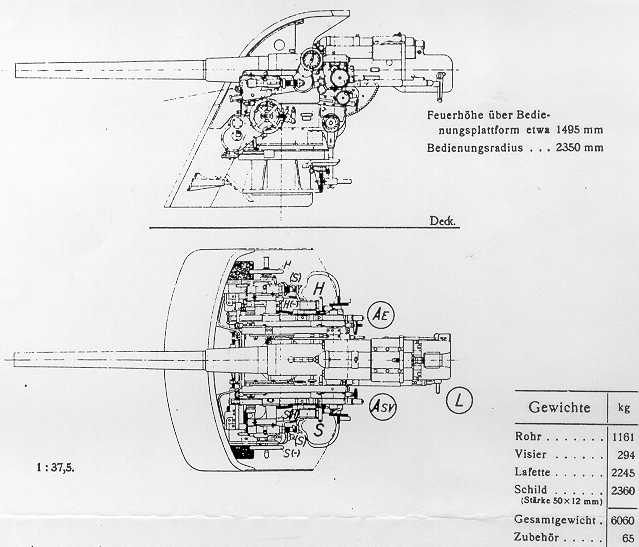
Standard light gun on all ships and submarines (designed in 1890 and entered service in 1892) of the Kaiserliches Marine until 1920 and beyond. They were quick to operate yet however limited in weight to do effective damage; Mostly usable against small ships, sailships, yachts, coastal steamers, trawlers, barges and such. More on these on navweaps.
⚙ specifications 8,8 cm SK L/30 |
|
| Weight | 644 kilograms (1,420 lb) |
| Lenght | 2.64 meters (8 ft 8 in) |
| Elevation/Traverse | MPL C/89: -10° to +20°, 300° |
| Loading system | horizontal sliding-wedge breech |
| Muzzle velocity | 590 m/s (1,900 ft/s) |
| Range | 7,300 metres (8,000 yd) at +20° |
| Crew | 4 |
| Round | Fixed 7 kgs (15 lb) 3.5 in |
| Rate of Fire | 15 RPM |
1,05 cm SK L/45 deck gun
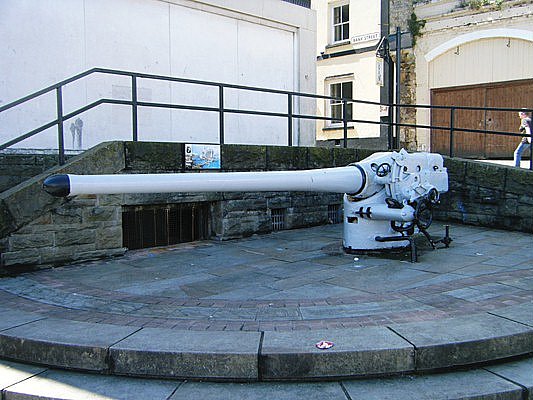
The 10.5 cm SK L/45 gun was designed and manufactured by Peddinghaus, being produced until 1945 on a variety of cradles, usually mounted on a conical pedestal mount, in that case, the latter was bolted to the submarine deck, replacing the 8.8 cm gun. These particular guns were carefully designed according to submarine operations requirements, and streamlined in design. Many items were also manufactured from brass to resist corrosion. That was certainly a boost for surfaced operations, given its double range and shell weight. At least these could deal with steamers and spared torpedoes. Among all victories earned by these ships, circa 1500 vessels, perhaps 20% were due to gunfire… More on navweaps
⚙ specifications 1,05 cm SK L/45 |
|
| Weight | 1,450 kilograms (3,200 lb) |
| Dimensions | 472.5 cm (15 ft 6 in) oa x 6.8 mm (0.27 in) |
| Elevation/Traverse | MPL C/06: -10° to +30°, 360° |
| Loading system | horizontal sliding-block breech |
| Muzzle velocity | 710 m/s (2,300 ft/s) |
| Range | MPL C/06: 12,700 m (41,700 ft) |
| Round | Fixed Brass Casing 25.5 kg (56 lb), 17.4 kg (38 lb) 4.1 in HE |
| Rate of Fire | 15 RPM |



⚙ U31 specifications |
|
| Displacement | 685 t surfaced, 878 t submerged |
| Dimensions | 64.70 x 6.32 x 3.56m (212 ft 3 in x 20 ft 9 in x 11 ft 8 in) |
| Propulsion | 2 shafts 1,850 PS Krupp diesels, 2× 1,200 PS (883 kW; 1,184 shp) Doppelmodyn EM |
| Speed | 16.4 knots surfaced/9.7 knots submerged |
| Range | 8,790 nmi (16,280 km; 10,120 mi)/8 knots surfaced, 80 nmi/5 knots submerged |
| Test depth | 50 m (164 ft 1 in) |
| Armament | 4x 50 cm TTs (20 in) (2 bow, 2 stern), 6 torpedoes, 8.8 cm SK L/30, later 10.5 cm SK L/45 guns |
| Crew | 4 officers, 31 enlisted |
Most succesful submarines of all times ?
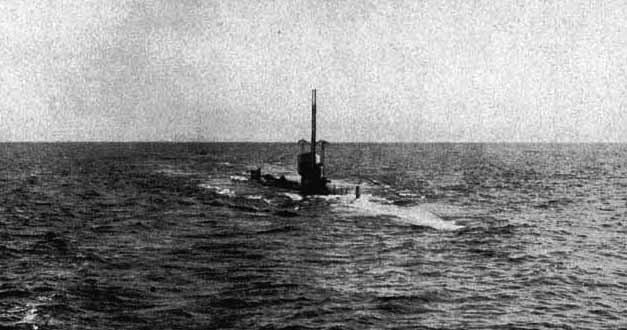

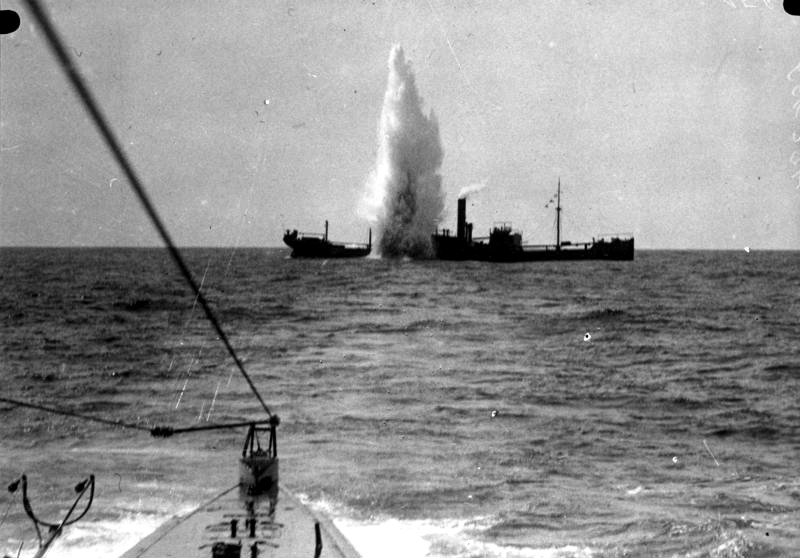
U31 class top Ace: Lothar von A. De la Periere
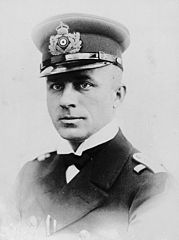 “Lothar Eugen von Arnauld de La Perière (born March 18, 1886 Posen (Poznań) died February 24, 1941, Le Bourget, FR. This German officer was the prominent, second best German submarine commander during the First World War. He sank 194 ships equivalent to 453,716 tons, 189 of which were were merchant ships, the rest military. He won most of his victories when surfaced with deck guns, in the Mediterranean. He also won the highest military awards at the time. He returned to active service during World War II as a vice admiral, but was killed in a plane crash near Paris in 1941 while participating in secret negotiations with the Vichy government.
“Lothar Eugen von Arnauld de La Perière (born March 18, 1886 Posen (Poznań) died February 24, 1941, Le Bourget, FR. This German officer was the prominent, second best German submarine commander during the First World War. He sank 194 ships equivalent to 453,716 tons, 189 of which were were merchant ships, the rest military. He won most of his victories when surfaced with deck guns, in the Mediterranean. He also won the highest military awards at the time. He returned to active service during World War II as a vice admiral, but was killed in a plane crash near Paris in 1941 while participating in secret negotiations with the Vichy government.
Back to WWI he seconded Admiral Hugo von Pohl in Berlin and at first went to the naval airship division (Marine Luftschiff Abteilung) before moving to the U-boat branch in 1915. After training in Pola her took command of U-35 in November, making 14 patrols dring which he obtained his 189 merchants, two entente gunboats and mostly use his pair of 88 mm deck artillery in preference to torpedoes, but before that, boarded the ships and had the crew lowered into lifeboats. Essentially ha scuttled these afrerwards. On October 4, 1916, he torpedoed and sank the troop transport Gallia, however, which made 1,740 victims. In May 1918, he was assigned to the brand new U-139 and sank five more ships for 7,008 tons. He was awarded the Iron Cross of the Second and First Class, Pour le Mérite medal (blue max) in 1916 and the Knight’s Cross of the Imperial Order of Leopold, highest Austrian decoration for his service in the Adriatic. It should be noted however that the absolute top scorer of all U-Boat crews was Otto Steinbrick, which sank 206 ships vs. 193 for Lothar. He served on smaller U-boats, U6, UB10, UB18, UC65 and UB57. But de la Periere remained the U-31 class top scorer.
Career of the U31 class
 U31 (1914)
U31 (1914)
U-31 was laid down on 12 October 1912, launched on 7 January 1914 and commissioned on 18 September 1914. She sailed from Wilhelmshaven on 13 January 1915, but disappeared shortly thereafter. It was assumed she had struck a mine somewhere in the North Sea. Her wreck confirmed this, rediscovered in 2012 about 55 miles (89 km) off the coast of East Anglia during surveys for an offshore wind farm. Formal identidfication was made on 9 September 2015 when divers procured the hull number engraved on her navigation equipment.
 U32 (1914)
U32 (1914)
U32 was laid down on 8 November 1912, launched on 28 January 1914, commissioned on 3 September 1914. She conducted 11 patrols, sank 37 merchant ships totalling 106,035 gross register tons (GRT) and one warship for 14,000 tons: This was on 9 January 1917, East of Malta, the British pre-dreadnought battleship HMS Cornwallis. Fortunately she sank slowly but lost 15 lives initially caused by the explosion or trapped inside.
 U33 (1914)
U33 (1914)
U33 was Laid down on 7 November 1912, she was Launched on 19 May 1914 and commissioned on 27 September 1914. She joined the Kiel School for trial, sailed to Emden on 12 January 1915, was attached to the 4th Half Flotilla. On 24–25 January 1915 she patrolled on the Bight, where enemy battlecruisers were reported and on 30 January her patrol was cut short due to diesel issues. She made two more patrols on 18–20 and 21-22 February. On 27 February – 10 April she transited through the English Channel into the Atlantic, sinking underway two sailing vessels.
On 28 March 1915 she spotted the Great Eastern Railway’s SS Brussels, and intimated her to stop. Instead, captain Charles Fryatt ordered full steam ahead and attempted to ram U-33, which quick dive save her. She served under Kptlt. Gausser until the Autumn 1917. She was back in the Noth Sea by May 1915 and in June patrolled off the west coast of Scotland. She sank 2 freighters, took one as prize. By August 1915 she was in the Bight Anti-air raid patrol and until 15 September 1915 joine dthe Mediterranean, sank five ships. Sailed to Cattaro, 15 September and then Constantinople Half Flotilla. Until 9 October 1915 eastern Mediterranean, sank 10 ships. Until 6 December central Mediterranean, sank 13 shios, and on 5 December exchanged ginfire with the drifter HOLLIBANK, Straits of Otranto. Took a neutral Greek ship off Piraeus, made POW Stanley Wilson, King’s messenger. 30 March 1916 sank the hospital ship “Portugal”. The latter was towing a small flat-bottomed barge carrying wounded infantry. She was caught by U33 stopped dead off Rizeh, Turkish coast (Black Sea) in repairs with a staff of Red Cross workers on board. They spotted the periscope but since they were protected by the Hague conventions, no evasive actions were taken. A first torpedo missed, and another fired under 30 feet hit near her engine room, breaking her in two and of 273 on board, 158 were rescued.
Between April 1916 and November 1916 she was operating mostly on the eastern Black Sea between Constantinople and Varna. April 1917, back in the Adriatic. Until 10 February 1918 was based in Cattaro for eastern Mediterranean cruises, sank two cargos, 2 sailing vessels, damaged to more. 1–17 May 1918 she sailed to Port Said, sank a cargo, one sailing vessel, attacked 2 ships but convoy escaped. On May 15 May she broke off due t engine issues, returned to Cattaro. Until 26 September 1917 she made an east med patrol, sank one cargo, 12 sailing vessels. 19 October 1918 she left Cattaro for Kiel, caught by naval trawler on 1 November, escaped. later joined UB-51 and UB-105. Surrendered to British at Harwich January 16, 1919.
 U34 (1914)
U34 (1914)
She was laid down on 7 November 1912, Launched on 9 May 1914 and commissioned on 5 October 1914. U-34 made 17 patrols, sinking 119 ships for 257,652 gross register tons (GRT) total; damaging five more for 14,208 GRT. She surrendered in 1919.
 U35 (1914)
U35 (1914)
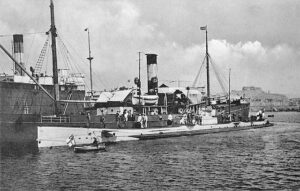 Laid down 20 December 1912 Launched 18 April 1914 U35 was commissioned on 3 November 1914 and entered service on 3 November 1914, under command of Kapitänleutnant Waldemar Kophamel, chief engineer Hans Fechter. She was assigned to the II Flottille stationed in Heligoland. She started patrols in the North Sea, sinking 17 merchant ships (25,716 GRT. Later) and later paired with U-34 after at Cattaro, sinking 2 more (3,724 GRT.), the two more cruises, 13 merchants for 51,594 GRT.On 23 October 1915 she sank the Marquette in the Aegean Sea, carrying an Ammunition Column of the 29th Division and staff of the 1st New Zealand Stationary Hospital. She sank the merchant ship Roma in Cartagena on June 21, 1916, which angered Spanish authorities.
Laid down 20 December 1912 Launched 18 April 1914 U35 was commissioned on 3 November 1914 and entered service on 3 November 1914, under command of Kapitänleutnant Waldemar Kophamel, chief engineer Hans Fechter. She was assigned to the II Flottille stationed in Heligoland. She started patrols in the North Sea, sinking 17 merchant ships (25,716 GRT. Later) and later paired with U-34 after at Cattaro, sinking 2 more (3,724 GRT.), the two more cruises, 13 merchants for 51,594 GRT.On 23 October 1915 she sank the Marquette in the Aegean Sea, carrying an Ammunition Column of the 29th Division and staff of the 1st New Zealand Stationary Hospital. She sank the merchant ship Roma in Cartagena on June 21, 1916, which angered Spanish authorities.
On 9 November 1915 with U-34 she sank the large SS Californian, delivering the coup-de-grace after U-34. U35 also dealt with the French patrol boat towing her. She would also met RMS Olympic but was not in the best position.
On 13 November 1915, Kptlt. de la Perière took command, making 15 missions mostly in the Mediterranean, sinking 187 merchants (417,682 GRT) as well as the British gunboat HMS Primula on 29 February 1916 and French gunboat Rigel on 2 October 1916 and later the Armed merchant cruiser La Provence carrying 1,800 French troops off Cerigo Island (990 lost).
Hr 14th patrol from 26 July to 20 August 1916 was the most successful submarine patrol in history. She sank 54 merchants (90,352 GRT), mostly by guns as she only had 10 torpedoes and no tender to refill her. On 4 October 1916, she sank the French large troopship SS Gallia (1,800 men lost).
Then Kptlt. Ernst von Voigt took command on 17 March 1918, making two patrols between 7 September and 9 October 1918, but the boat’s engines died out, ending her career. On 14 October 1918, Kptlt. Heino von Heimburg took command as she was moved to Kiel for an overhaul, but it never happened. She was surrendered and transferred to England, Blyth, displayed here to the public from 1919 to 1920, and BU.
 U36 (1914)
U36 (1914)
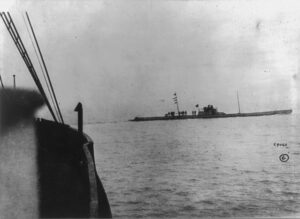 U-36 was laid down on 2 January 1913 at Germaniawerft, launched on 6 June 1914, commissioned on 14 November 1914, under command of Kapitänleutnant Ernst Graeff. After February 1915 acceptance trials at Kiel, she was assigned to the 2d Half-Flotilla, North Sea in March, but her indicative was soon caught by British Naval Intelligence “Room 40”. She was in the Heligoland Bight on 29-30 March, then 23 April.
U-36 was laid down on 2 January 1913 at Germaniawerft, launched on 6 June 1914, commissioned on 14 November 1914, under command of Kapitänleutnant Ernst Graeff. After February 1915 acceptance trials at Kiel, she was assigned to the 2d Half-Flotilla, North Sea in March, but her indicative was soon caught by British Naval Intelligence “Room 40”. She was in the Heligoland Bight on 29-30 March, then 23 April.
Later in the North Sea she sank the 1,966-ton Danish steamer Lilian Drost on 8 May and captured the 1,241-ton Swedish steamer Björn on 10 May as prize, and the 654-ton Dutch steamer Niobe.
U-36 was back to the North Sea station on 17 July and sailed for the north-northwest coast of Scotland, sinking 3 steamers, 11 smaller vessels. On 22 July she sank the 3,644-ton Russian Rubonia and rampaged fishing vessels west of the Orkney Islands, sank 9 by gunfire, plus 1 sailing vessel, one more as prize, and on the 23th she sank the 1,505-ton Frenchman Danae under prize rules and the 3,819-ton Norwegian Fimreite.
24 July 1915 was her last mission. She intercepted and captured the American windjammer Pass of Balmaha, sent to Cuxhaven and refitted as the only German sailing merchant raider under Count Felix von Luckner, the legendary Seeadler.
In the afternoon off North Rona, Outer Hebrides she spotted a cargo and closed for the usual prize… But this was a British Q-ship, “Prince Charles” (Lieutenant Mark Wardlaw). He spotted U-36 as she was about to board the Danish vessel SS Luise. U-36 signaled Prince Charles to stop, firing a warning shot at her bow. The Q-ship complied and swang out her boats, watiing fror U36 to come at 600 m when she hoisted the British war flag, swang open all her fake walls to reveal her main guns and immediately took aim and fire. U-36 took direct hits and sank as a result. What was later a major “blue on blue” that when the captain of Luise, which moved to pick up the survivors saw with horror, Prince Charles turn her guns on them, believing she was the U-Boat supply ship. She sank in turn, but all were rescued. Kptlt. Graeff survived with 15 crewmen were saved, 18 lost. U-36 was the first sunk by a Q-ship and Wardlaw received a DSO, the crew awarded a prize sum of £1,000.
 U37 (1914)
U37 (1914)
U37 was laid down on 2 January 1913, launched on 25 August 1914 and commissioned on 9 December 1914. She had only three kills during her initial patrols: On 25 March 1915 she reported sank (only damaged) the British SS Delmira (3,459t) sank on 31 March 1915 the French Emma (1,617) and on 1 April 1915 the British SS Seven Seas (1,194t). She struck a mine on 30 April 1915 in Straits of Dover and sank with all hands.
 U38 (1914)
U38 (1914)
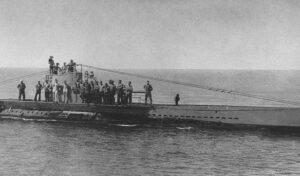 U38 was laid down on 25 February 1913, she was launched on 9 September 1914 and Commissioned on 15 December 1914. She was the 3rd most successful U-boat in WW2, sinking 134 merchants (287,811 GRT). Most were earned by Kptlt. Max Valentiner (Pour le Mérite). In December 1915 he infamously sank the passenger liners Ancona and Persia, controversial as this was without warning, not under Prize rules. In 1917 Kptlt. Wilhelm Canaris took command. 15 years later as an Admiral he became the famous head of the Abwehr (German Mil. Intel.) from 1935 to 1944. U-38 was surrendered to France, docked in Brest in 1919, visited by the public and then broken up.
U38 was laid down on 25 February 1913, she was launched on 9 September 1914 and Commissioned on 15 December 1914. She was the 3rd most successful U-boat in WW2, sinking 134 merchants (287,811 GRT). Most were earned by Kptlt. Max Valentiner (Pour le Mérite). In December 1915 he infamously sank the passenger liners Ancona and Persia, controversial as this was without warning, not under Prize rules. In 1917 Kptlt. Wilhelm Canaris took command. 15 years later as an Admiral he became the famous head of the Abwehr (German Mil. Intel.) from 1935 to 1944. U-38 was surrendered to France, docked in Brest in 1919, visited by the public and then broken up.
 U39 (1915)
U39 (1915)
U-39 was laid down on 27 March 1913, launched on 26 September 1914 and commissioned on 13 January 1915. She was second most successful U-boat by sinking 149 merchants (404,774 GRT), most under Kapitänleutnant Walther Forstmann (Pour le Mérite). From January to mid-1917, Martin Niemöller was his coxswain, author of the 1946 poem “First they came…” a fervent antinazi. Lastly in 1917 and 1918 no other than Karl Dönitz was U-39’s watch officer. No need to explain his career. On 27 April 1918, U-39 sailed from Pola under Kapitänleutnant Heinrich Metzger for a Western Mediterranean patrol and from 17 May, played with SM UB-50, preying on a convoy North of Oran, sinking the British Sculptor (4,874 GRT).
At 13:50 on 18 May, U-39 was attacked by two French seaplanes, crash-dived, hit 12 meters when 2 nea-missed flooded her after torpedo room and jammed her diving planes. She avoided sinking by having her tanks blown to surface and limped to the nearest Spanish harbour in Cartagena when at 17:00, she was caught by two seaplanes, fough back, was near-missed, but lost two. She reached port in the evening and remained interned, later surrendered to France on 22 March 1919, BU in Toulon in 1923.
 U40 (1915)
U40 (1915)
U-40 was Laid down 3 April 1913, launched on 22 October 1914 and commissioned on 14 February 1915 under Kpt Gerhardt Fürbringer. She made just one patrol without sinking a ship and on the morning of 23 June 1915 she stopped the trawler Taranaki in the North Sea, whuch happened to be a Q-ship, in liaison to the submerged HMS C24 by tow line and telephone cable. When U-40 stopped C24 tried to slip the tow line but the release mechanism failed. Yet she managed to manoeuvre and with adjusted trim despite the chain close to her propellers, she fired a single torpedo, hitting amidships. Only the 3 in the conning tower survived. The wreck was rediscovered on March 2009 by Marine Quest 40 nmi (74 km; 46 mi) off Eyemouth, Berwickshire.
 U41 (1915)
U41 (1915)
U-41 was laid down 22 April 1913, launched on 10 October 1914 and commissioned on 1 February 1915. Her career was short, ended by another Q-ships. After her first patrol when she sank the “Anglo-Columbian” on 23 December, HMS Wyandra was sent to the latest location flagged as the US merchantman Baralong from Falmouth. U-41 later stopped the 6,651 GRT “Urbino” on 24 December, 70 miles from Bishop Rock. She sent a boarding party to inspect her and after finding war material had the crew evacuated into lifeboats. She was trying to sink Urbino with gunfire when Baralong arrived at 9:45, flying the US flag and turned away visibly afraid. During the chase, U-41 signalled her to prepare her papers and lower a boat. Baralong complied, and revealed her guns at 700 yards. The whole crew took part, armed with rifles, including marksmen Royal Marines onboard. U-41’s captain ordere to abandon the deck gun and prepared to dive when hits in her conning tower killed Kapitänleutnant Hansen and six of his staff. U-41 listed, dived, rose again and sank for good. Oberleutnant zur See Iwan Crompton and a helmsman, both injured, escaped. 42 from Urbino were also picked up by HMS Wyandra. Both sides would later complain about violation of the rules of war and this generated widespread outrage in Germany.
Read More/Src
Books
Gröner, Erich; Jung, Dieter; Maass, Martin (1991). U-boats and Mine Warfare Vessels. German Warships 1815–1945. Vol. 2. Conway
Eberhard Rössler: Geschichte des deutschen U-Bootbaus – Band 1. Bernard & Graefe Verlag 1996
Bodo Herzog: Deutsche U-Boote 1906-1966. Manfred Pawlak Verlags GmbH, Herrschingen 1990
Spindler, Arno (1966). Der Handelskrieg mit U-Booten. 5 Vols. Berlin: Mittler & Sohn.
Beesly, Patrick (1982). Room 40: British Naval Intelligence 1914-1918. London: H Hamilton.
Halpern, Paul G. (1935). A Naval History of World War I. New York: Routledge.
Roessler, Eberhard (1997). Die Unterseeboote der Kaiserlichen Marine. Bonn: Bernard & Graefe.
Schroeder, Joachim (2002). Die U-Boote des Kaisers. Bonn: Bernard & Graefe.
Koerver, Hans Joachim (2008). Room 40: German Naval Warfare 1914-1918. Vol I/II., The Fleet in Action. Steinbach: LIS Reinisch.
Bogedain, Clemens (2016). Lothar v. Arnauld de la Perière. Erfolgreichster U-Bootkommandant der Seekriegsgeschichte. Franz Steiner Verlag.
Links
https://uboat.net/wwi/men/commanders/276.html
https://uboat.net/ Ioannes Klasim
https://uboat.net/ Wilhelm Canaris
uboat.net/ U34
Lothar von arnaud the la Periere
.iwm.org.uk/collections
tvre.org/en/torpedo-attacks-during-wwi
navweaps.com/ PreWWII.php
virtualdockyard.co.uk/ PLANS U-BOATS
sakhalianet type_U_31.htm
en.wikipedia.org Type_U_31_submarine
Videos
Model Kits
mozaweb.com/ preview
sdmodelmakers.com/ u-31-class
kits on scalemates.com
3D

3D rendition
mozaweb.com/

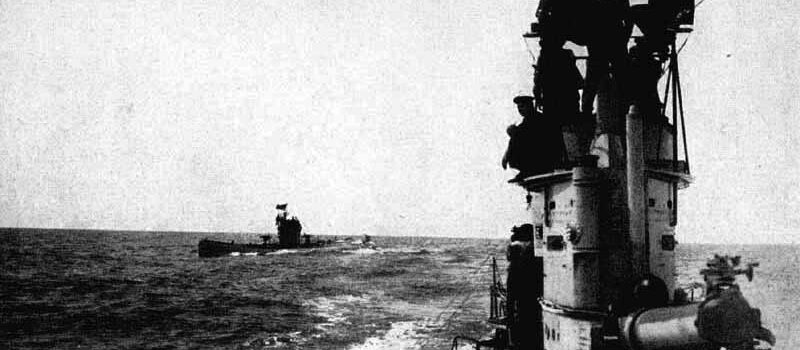
 Latest Facebook Entry -
Latest Facebook Entry -  X(Tweeter) Naval Encyclopedia's deck archive
X(Tweeter) Naval Encyclopedia's deck archive Instagram (@navalencyc)
Instagram (@navalencyc)





 French Navy
French Navy Royal Navy
Royal Navy Russian Navy
Russian Navy Armada Espanola
Armada Espanola Austrian Navy
Austrian Navy K.u.K. Kriegsmarine
K.u.K. Kriegsmarine Dansk Marine
Dansk Marine Nautiko Hellenon
Nautiko Hellenon Koninklije Marine 1870
Koninklije Marine 1870 Marinha do Brasil
Marinha do Brasil Osmanlı Donanması
Osmanlı Donanması Marina Do Peru
Marina Do Peru Marinha do Portugal
Marinha do Portugal Regia Marina 1870
Regia Marina 1870 Nihhon Kaigun 1870
Nihhon Kaigun 1870 Preußische Marine 1870
Preußische Marine 1870 Russkiy Flot 1870
Russkiy Flot 1870 Svenska marinen
Svenska marinen Søværnet
Søværnet Union Navy
Union Navy Confederate Navy
Confederate Navy Armada de Argentina
Armada de Argentina Imperial Chinese Navy
Imperial Chinese Navy Marinha do Portugal
Marinha do Portugal Mexico
Mexico Kaiserliche Marine
Kaiserliche Marine 1898 US Navy
1898 US Navy Sovietskiy Flot
Sovietskiy Flot Royal Canadian Navy
Royal Canadian Navy Royal Australian Navy
Royal Australian Navy RNZN Fleet
RNZN Fleet Chinese Navy 1937
Chinese Navy 1937 Kriegsmarine
Kriegsmarine Chilean Navy
Chilean Navy Danish Navy
Danish Navy Finnish Navy
Finnish Navy Hellenic Navy
Hellenic Navy Polish Navy
Polish Navy Romanian Navy
Romanian Navy Turkish Navy
Turkish Navy Royal Yugoslav Navy
Royal Yugoslav Navy Royal Thai Navy
Royal Thai Navy Minor Navies
Minor Navies Albania
Albania Austria
Austria Belgium
Belgium Columbia
Columbia Costa Rica
Costa Rica Cuba
Cuba Czechoslovakia
Czechoslovakia Dominican Republic
Dominican Republic Haiti
Haiti Hungary
Hungary Honduras
Honduras Estonia
Estonia Iceland
Iceland Eire
Eire Equador
Equador Iran
Iran Iraq
Iraq Latvia
Latvia Liberia
Liberia Lithuania
Lithuania Mandchukuo
Mandchukuo Morocco
Morocco Nicaragua
Nicaragua Persia
Persia San Salvador
San Salvador Sarawak
Sarawak Uruguay
Uruguay Venezuela
Venezuela Zanzibar
Zanzibar Warsaw Pact Navies
Warsaw Pact Navies Bulgaria
Bulgaria Hungary
Hungary

 Bundesmarine
Bundesmarine Dutch Navy
Dutch Navy Hellenic Navy
Hellenic Navy Marina Militare
Marina Militare Yugoslav Navy
Yugoslav Navy Chinese Navy
Chinese Navy Indian Navy
Indian Navy Indonesian Navy
Indonesian Navy JMSDF
JMSDF North Korean Navy
North Korean Navy Pakistani Navy
Pakistani Navy Philippines Navy
Philippines Navy ROKN
ROKN Rep. of Singapore Navy
Rep. of Singapore Navy Taiwanese Navy
Taiwanese Navy IDF Navy
IDF Navy Saudi Navy
Saudi Navy Royal New Zealand Navy
Royal New Zealand Navy Egyptian Navy
Egyptian Navy South African Navy
South African Navy






























 Ukrainian Navy
Ukrainian Navy dbodesign
dbodesign